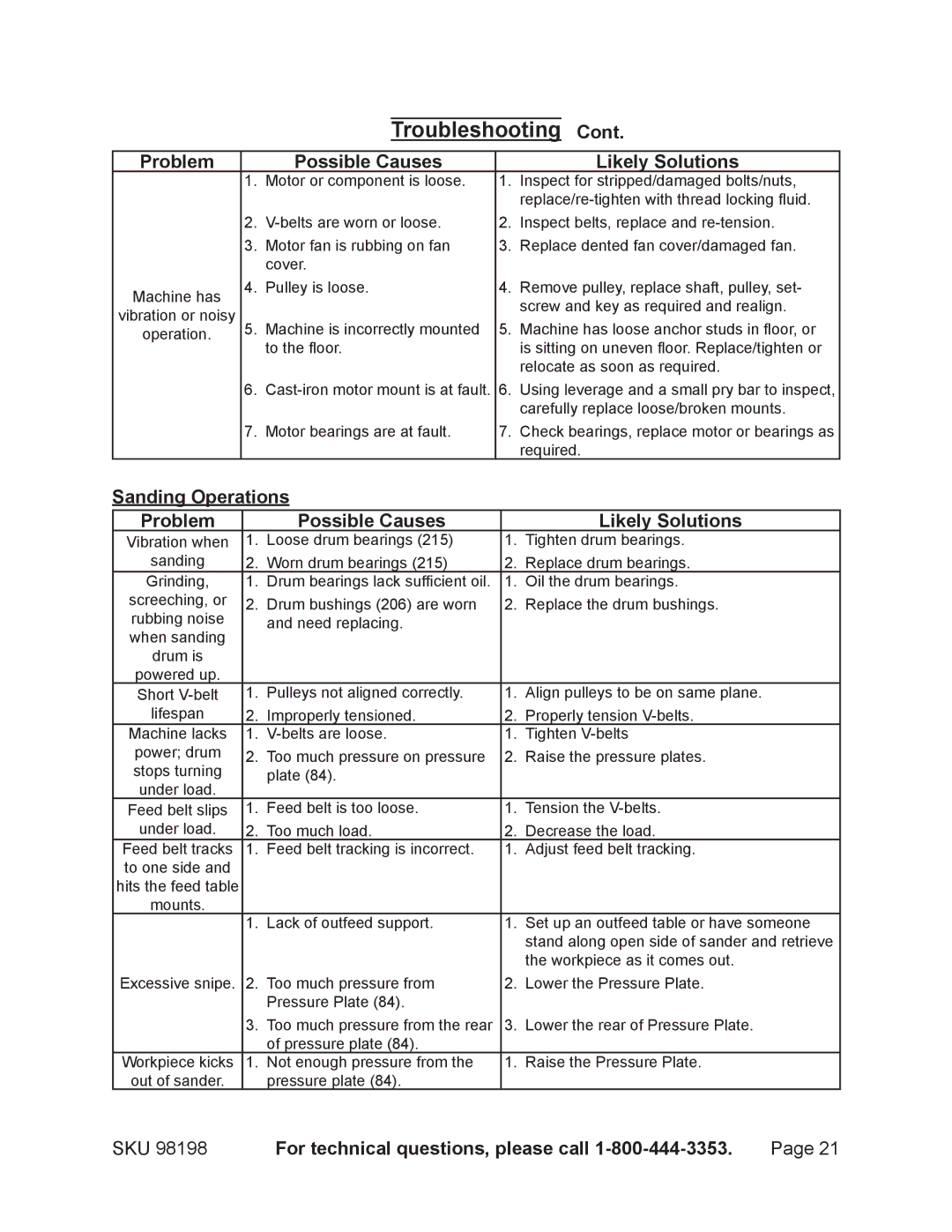
Troubleshooting Cont.
Problem |
| Possible Causes |
| Likely Solutions | |
| 1. | Motor or component is loose. | 1. | Inspect for stripped/damaged bolts/nuts, | |
|
|
|
| ||
| 2. | 2. | Inspect belts, replace and | ||
| 3. | Motor fan is rubbing on fan | 3. | Replace dented fan cover/damaged fan. | |
|
| cover. |
|
| |
Machine has | 4. | Pulley is loose. | 4. | Remove pulley, replace shaft, pulley, set- | |
|
|
| screw and key as required and realign. | ||
vibration or noisy |
|
|
| ||
5. | Machine is incorrectly mounted | 5. | Machine has loose anchor studs in floor, or | ||
operation. | |||||
|
| to the floor. |
| is sitting on uneven floor. Replace/tighten or | |
|
|
|
| relocate as soon as required. |
6.
7. Motor bearings are at fault. | 7. Check bearings, replace motor or bearings as |
| required. |
Sanding Operations |
|
| ||
Problem |
| Possible Causes |
| Likely Solutions |
Vibration when | 1. | Loose drum bearings (215) | 1. | Tighten drum bearings. |
sanding | 2. | Worn drum bearings (215) | 2. | Replace drum bearings. |
Grinding, | 1. | Drum bearings lack sufficient oil. | 1. | Oil the drum bearings. |
screeching, or | 2. | Drum bushings (206) are worn | 2. | Replace the drum bushings. |
rubbing noise |
| and need replacing. |
|
|
when sanding |
|
|
|
|
drum is |
|
|
|
|
powered up. |
|
|
|
|
Short | 1. | Pulleys not aligned correctly. | 1. | Align pulleys to be on same plane. |
lifespan | 2. | Improperly tensioned. | 2. | Properly tension |
Machine lacks | 1. | 1. | Tighten | |
power; drum | 2. | Too much pressure on pressure | 2. | Raise the pressure plates. |
stops turning |
| plate (84). |
|
|
under load. |
|
|
|
|
Feed belt slips | 1. | Feed belt is too loose. | 1. | Tension the |
under load. | 2. | Too much load. | 2. | Decrease the load. |
Feed belt tracks | 1. | Feed belt tracking is incorrect. | 1. | Adjust feed belt tracking. |
to one side and |
|
|
|
|
hits the feed table |
|
|
|
|
mounts. |
|
|
|
|
1.Lack of outfeed support. 1. Set up an outfeed table or have someone stand along open side of sander and retrieve the workpiece as it comes out.
Excessive snipe. | 2. | Too much pressure from | 2. | Lower the Pressure Plate. |
|
| Pressure Plate (84). |
|
|
| 3. | Too much pressure from the rear | 3. | Lower the rear of Pressure Plate. |
|
| of pressure plate (84). |
|
|
Workpiece kicks | 1. | Not enough pressure from the | 1. | Raise the Pressure Plate. |
out of sander. |
| pressure plate (84). |
|
|
SKU 98198 | For technical questions, please call | Page 21 |
